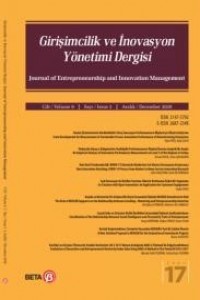Proje Yönetiminde Zaman ve Maliyet Odaklı Bütünleşik Planlama Yaklaşımı ve Bir Uygulama
Kaynak Kısıtlı Proje Yönetimi, CPM, PERT, Doğrusal Programlama
A Time and Cost-Based Integrated Planning Approach for Project Management and An Application
Resource-Constrained Project Management, CPM, PERT, Linear Programming.,
___
- Barutçugil, İ.S. (2008), “Proje Yönetiminde Örgütleme Sorunu ve Proje Örgütü”, Uludağ Üniversitesi İktisadi ve İdari Bilimler Fakültesi Dergisi, 4(2), 157-175.
- Belfort, A.C., Martens C.D.P. ve Freitas, H.M.R. (2016), “Entrepreneurship in project management systems: proposal of a model and preliminary empirical evidence”, Journal of Information Systems and Technology Management, 13(3), 405-422
- Blazewicz, J., Lenstra, J.K. ve Kan, R. (1983), “Scheduling subject to resource constraints: classification and complexity”, Discrete Applied Mathematics, 5(1), 11-24.
- Büyükşalvarcı, A. (2006), “Faaliyet Tabanlı Maliyetleme ve Bankalarda Bir Uygulama”, Selçuk Üniversitesi Karaman İ.İ.B.F. Dergisi, Sayı 10, 160-180.
- Cheng, J., Fowler, J., Kempf, K. ve Mason S. (2015), “Multi-mode resource-constrained project scheduling problems with non-preemptive activity splitting”, Computers and Operations Research, 53, 275–287.
- Doskocil, R. (2016), “ The level of use of project management methods, techniques and tools and their impact on project success - selected region of Czech Republic”, Periodica Polytechnica.Social and Management Sciences, 24(1), 14-24.
- Fonrouge, C., Bredillet, C. ve Fouché, C. (2018) “Entrepreneurship and project management relationships: So far so good? Dialogic conversation and Luhmannian perspective”, International Journal of Managing Projects in Business, https://doi.org/10.1108/ IJMPB-01-2018-0013
- Kolisch, R., ve Padman, R. (2001), “An integrated survey of deterministic project scheduling”, Omega, 29(3), 249-272.
- Kostalova, J., ve Tetrevova, L. (2018). “Proposal of project management methods and tools oriented maturity model”. Revista De Gestão e Projetos, 9(1), 1-23.
- Kutlu, N.T. (2001), “Proje planlama teknikleri ve PERT tekniğinin inşaat sektöründe uygulanması üzerine bir çalışma”, Dokuz Eylül Üniversitesi Sosyal Bilimler Enstitüsü Dergisi, 3(2), 16
- Lawler, E.L. (1976) Combinatorial Optimization: Networks and Matroids, Holt, Rinehart and Winston, New York, N.Y.
- Luu, V.T., Kim, S.Y., Nguyen V.T. ve Ogunlana, S.O. (2009), “Quantifying schedule risk in construction projects using Bayesian belief networks”, International Journal of Project Management, 27(1), 39–50.
- Martens, C.D.P., Carneiro, K.D.A., Martens, M.L. ve Silva, D. (2015), “Relationship between entrepreneurial orientation and project management maturity in Brazilian software firms”, Iberoamerican Journal of Strategic Management, 14(2), 72-91.
- Nasseri, H.A., ve Aulin, R. (2016), “Enablers and barriers to project planning and scheduling based on construction projects in Oman”, Journal of Construction in Developing Countries, 21(2), 1–20, doi: 10.271315/jcdc2016.21.2.1.
- Ng, J.J. (2018), “A Deeper Look Into a Project Management Tool: The Change Register”, IEEE Engineering Management Review, 46 (1), 24-26.
- Oğuz, O. ve Bala, H. (1994), “A comparative study of computational procedures for the resource constrained project scheduling problem”, European Journal of Operational Research, 72(2), 406-416.
- Önal, G. (2009), “Yeniliğe karşı tüketici tepkisi ve tüketicilerin yenilikleri benimseme düzeyleri ile ilgili Isparta iline yönelik bir uygulama”, Afyon Kocatepe Üniversitesi Sosyal Bilimler Enstitüsü, Afyonkarahisar: Yüksek Lisans Tezi
- Özdamar, L. ve Ulusoy, G. (1996), “An iterative local constraints based analysis for solving the resource constrained project scheduling problem”, Journal of Operations Management, 14(3), 193-208.
- PMI. (2013), “A guide to the project management body of knowledge (PMBOK® guide)”, United States: Project Management Institute, Inc.
- Rad, P.F. ve Levin, G. (2002), The Advanced Project Management Office: A Comprehensive Look at Function and Implementation, Boca Raton, FL: CRC Press.
- Tecim, V. ve Sinan, G. (2009), “Süreç Odaklı Proje Planlama: Bir Uygulama”, Aksaray Üniversitesi İktisadi ve İdari Bilimler Fakültesi Dergisi, 1(2), 165-180.
- Turan, A.P. (1995), Proje Planlama ve Kullanılan Teknikler, Ankara: MPM Ulusoy, G. (2002), “Proje planlamada kaynak kısıtlı çizelgeleme”, https://www. academia.edu/17348163/Proje_planlamada_kaynak_kısıtlı_çizelgeleme, Erişim Tarihi: 17.08.2018
- Valls, V., Quintanilla, S. ve Ballestín, F. (2003), “Resource-constrained project scheduling: A critical activity reordering heuristic”, European Journal of Operational Research, 149(2), 282-301.
- Yu, F. (2012), “Strategic flexibility, entrepreneurial orientation and firm performance: evidence from small and medium-sized business (SMB) in China”, African Journal of Business Management, 6(4), 1711-1720.
- Zdanyte˙, K. ve Neverauskas, B. (2012), “Selection Appropriate Project Management Tool for Advanced Organization”, Economics and Management, 17(2), 782-787.
- ISSN: 2147-5792
- Başlangıç: 2012
- Yayıncı: Beta Basım Yayım Dağıtım A.Ş.
Lojistik 4.0 Teknolojilerinin Analizi için Metodolojik Yaklaşım
Gülçin BÜYÜKÖZKAN, Merve GÜLER
Proje Yönetiminde Zaman ve Maliyet Odaklı Bütünleşik Planlama Yaklaşımı ve Bir Uygulama
Aslı AKSOY, Mehmet AKANSEL, Canberk ATALAY, Atalay Meriç ÇAMLIBEL, Dilara YAŞAR, Duygu KESEROĞLU, Serdar VANLIOĞLU
Tugba GURCAYLILAR-YENİDOGAN, Seda Aslı YAVUZ
Kültürel Değişimin Ülkelerin Girişimcilik Faaliyetleri Üzerindeki Etkisi
